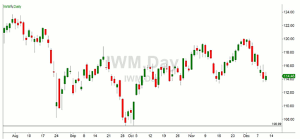Options instructor Russ Allen, of Online Trading Academy, highlights several reasons for why an options trader can make money if a stock moves up, or can also make money if it does nothing, or even if it moves down a little bit.
Trading options on a stock can sometimes make money for you even if you are a little bit wrong in your opinion about the stock. If you believe a stock will go up, you can put on a trade that makes money, if that happens, no surprise. But it can also make money if the stock does nothing at all, or even if it goes down a little, making you a little bit wrong.
There are several variations on this. In the simplest one, say there is a stock for which you have a bullish outlook. You then locate a price level to which you believe the stock is very unlikely to drop in the near future. You then sell a put option with a strike price at that lower level. If you are right and the stock goes up, you win, you keep the money you received for selling the put. If the stock does nothing, you still win. And you even win if the stock goes down, as long as it doesn’t go down too far.
Here’s an example. Below is a chart of IWM, the exchange-traded fund that tracks the level of the Russell 2000 Small-cap Index.
If we believed that IWM was likely to rally from the current level and was very unlikely to drop below the October lows around $107, we could sell put options at the $107 strike. As of December 10, we could have sold puts that expired a month out for about $.91 per share or $91 per 100-share contract.
For each $107 put that we sold, we would receive a premium of $91 immediately. In return, we would be obligated to buy the stock at $107 per share if it dropped to that level and remained below it on January 15. If it did not drop that far, the puts would expire and the money would be ours to keep.
So here is where we stood:
If IWM went up (we were right), we would make $91.
If IWM went sideways (we were not quite right), we would make $91.
If IWM went down but not below $107 (we were a little bit wrong), we would make $91.
If IWM went down below $107 but not by more than another $.91 (we were really wrong), we would still make some money but less than $91. The put owners would exercise their right to force us to buy the stock at $107 and we would own the IWM stock at a net cost of $106.09 per share. This was the $107 strike price, which we would be obligated to pay out; less the $.91 per share that we had received for selling the put in the first place.
And, if IWM went down below $106.09 (we were wrong), we would have a loss to whatever extent the stock was below $106.09 at expiration.
This is an example of the power of options. There are other versions of this strategy where we take more risk for potentially more profit; or conversely take steps to protect ourselves more fully, take less risk and accept a lesser profit. As long as we can form an opinion about the future direction of the stock that is just not too far wrong, we can profit by being willing to take a well thought out risk.
Knowing which risks to take is the essential skill for trading options…or anything else.
By Russ Allen, Instructor, Online Trading Academy






















